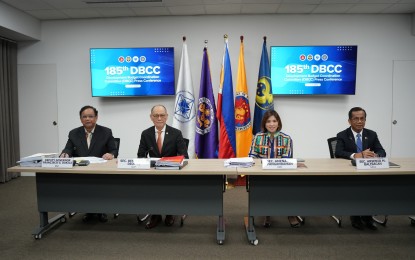
Economic team of President Ferdinand R. Marcos Jr. (Photo from DBM FB page)
MANILA – The proposed measure establishing the Maharlika Investment Fund (MIF) adheres to the fundamental principles of economic policy and financial market participation, the economic team of President Ferdinand R. Marcos Jr. said on Tuesday.
In a joint statement, the Department of Budget and Management (DBM), Department of Finance (DOF), National Economic and Development Authority (NEDA) and the Bangko Sentral ng Pilipinas (BSP) reaffirmed their support for the establishment of the Maharlika Investment Fund (MIF) as “a vehicle for economic growth.”
“The legal framework provided by Senate Bill (SB) No. 2020—approved by the Senate and adopted by the House of Representatives—follows fundamental principles of economic policy and financial market participation in favor of and for the ultimate benefit of the Philippine economy and the Filipino people,” the economic managers said.
The statement was issued after some 21 economists from the University of the Philippines (UP) urged Marcos and his economic team to “seriously” reconsider the MIF bill, saying the measure “violates fundamental principles of economics and finance.”
The economists and academics from the UP School of Economics, including former Socioeconomic Planning secretary and NEDA director general Ernesto Pernia, said the measure is “defective,” has “confused goals,” and abounds with “red flags.”
They also warned that the proposal posed serious risks to the economy and the public sector, “notwithstanding its proponents’ good intentions.”
The economic managers said SB 2020 imposes enough safeguards to minimize risks for shareholders and fund contributors, including the public sector.
They said the investment policies that will be formulated by the proposed Maharlika Investment Corp. (MIC) will include disclosure and transparency mechanisms.
“Further, approved investment policies of the MIC shall be posted on its website which shall be immediately updated and made accessible to the public. In the same vein, investment and risk management plans, strategies and activities of the MIC, involving the MIF, shall be disclosed and published on its website for public consumption,” they said.
“To ensure transparency and accountability, the MIC shall regularly publish on its website the terms and conditions of the arrangement with co-investors/joint-venture partners, as well as all financial statements and reports relative to the operations of the co-investment/joint venture,” they added.
They said the bill also contains a provision directing the absolute prohibition of pension and social funds from contributing to the MIC and MIF to ensure that fiscal resources, particularly the funds managed by the Social Security System and the Government Service Insurance System “are used solely for the purpose for which they were created.”
“The national government’s initial contribution of PHP50 billion shall be sourced from declared dividends of the BSP, government share in the income of the Philippine Gaming Corporation, and proceeds from privatization of government assets, as well as other sources of the National Government such as royalties/special assessments,” they said.
Attracting more investments
They also stressed that the proposed MIF is “not only beneficial but necessary at this point in time,” given the rising cost of debt.
They added that while the Philippines can offer investment opportunities, it remains a growing economy that needs to “explore vehicles to attract equity financing.”
“Hence, the MIC/MIF is an investment for the future that we need to start building now. It is an ideal vehicle and well-positioned to bring in investments as the Philippine economic outlook remains robust amid the global economic slowdown,” the economic managers said.
The economic managers also noted that various foreign investors such as the Japan Bank for International Cooperation (JBIC) and several US investors have already expressed interest for the proposed MIF.
“Let it be clear that the Administration remains focused and committed to the vital and urgent national agenda, with the MIF being one of the strategies towards this overarching goal of national development,” they said, stressing that the proposed creation of MIF is aligned with the Medium-Term Fiscal Framework (MTFF) and the 8-Point Socio-economic Agenda.
The economic team said the MIC and MIF also operationalize the Philippine Development Plan 2023-2028.
They added that the bill is aimed at executing and sustaining “high-impact” infrastructure and development projects, easing fiscal constraints, and maximizing expected returns for the country’s investments.
“The objectives are clear: to invest funds that are available in government instrumentalities and utilize them for investment purposes on the basis of their individual mandates,” they said.
Widening fiscal space in ‘near to medium term'
The economic managers said the proposed MIF also aims to optimize the use of government financial assets in maximizing returns because it is allowed to undertake more investment options.
They said the proposed wealth fund, as an additional vehicle for financing, is expected to widen the fiscal space in the near- to medium-term as it reduces heavy reliance on local funds and development assistance as the main financing mechanisms for infrastructure projects.
“By providing an alternative source to public infrastructure spending, there would be a bigger budgetary allowance for other priority expenditures,” they said.
They added that investing in the MIC would allow government financial institutions to possibly obtain “medium- to long-term returns that are higher than their 10-year average return.”
“For instance, the Land Bank of the Philippines (LBP) has a 10-year average return on investment (ROI) of 4.23 percent and the Development Bank of the Philippines (DPB) has a 10-year average ROI of 3.59 percent. Meanwhile, the expected return of Maharlika is estimated to be around 8.6 percent on average, much higher than their cost of capital and the return in their current investment places,” they said.
“This is based on simulations which take into consideration the blend of investment placements between the planned capital market investment sub-fund and sectoral investment sub-fund,” they added. (PNA)
